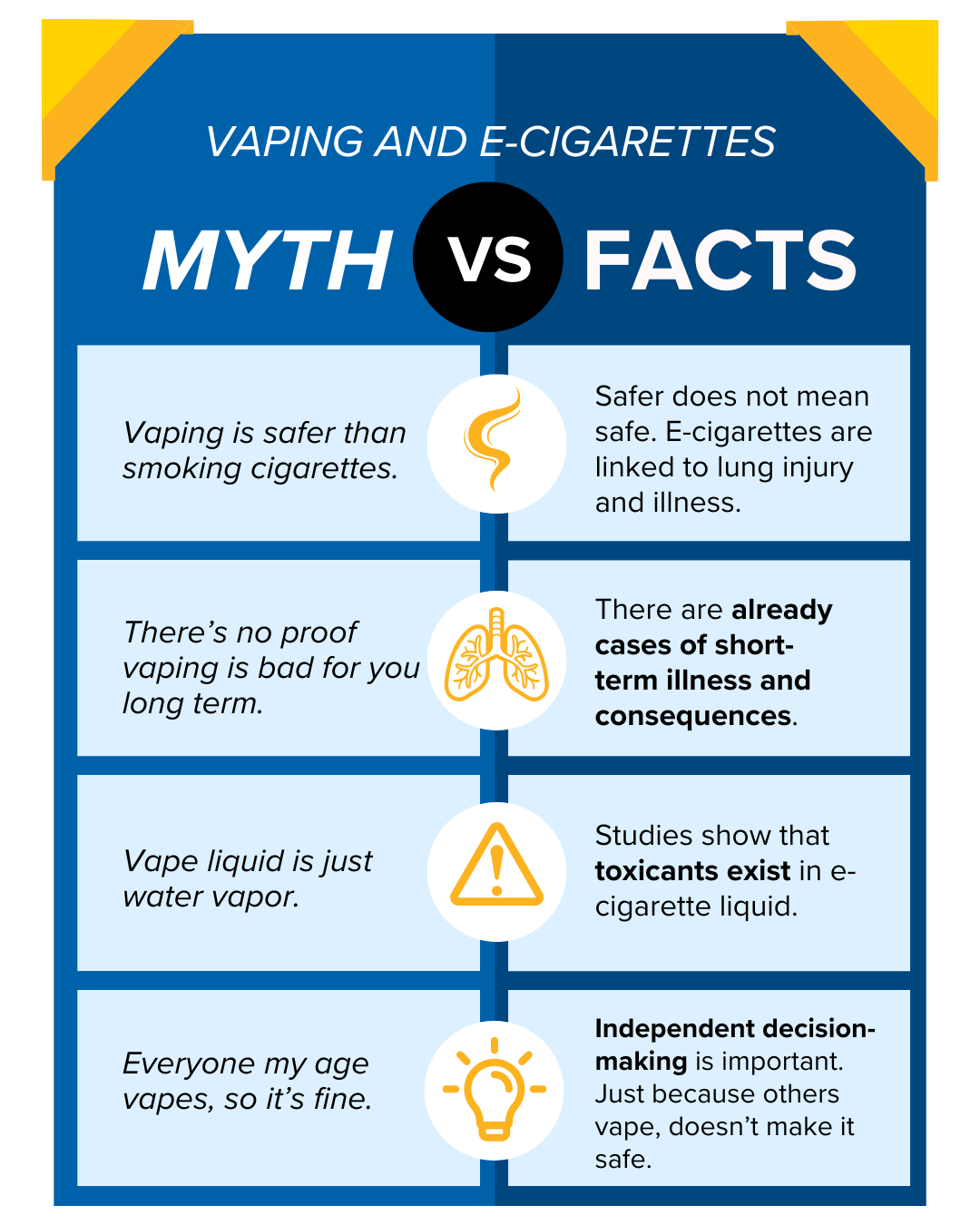Talking to Your Teen Who Vapes
The use of electronic nicotine products among adolescents has become a major concern. More than 2.1 million youth currently use e-cigarettes. Results from also show that of youth who vape, 9 out of 10 are using flavored e-cigarettes and over 25% are using them every day.

E-cigarettes, or vapes, are full of nicotine and pose serious health risks to children, teens, and adults. Vape pens are highly addictive and can be scentless, and they often contain more nicotine in one device than an entire pack of cigarettes. Combined with their ease of access, these factors add to their popularity.
As many parents know, teens often don’t want to listen or talk about tough topics like vaping. But having these conversations is crucial to your child’s health and well-being.
While it may seem like they’re not listening, they hear you, says Dr. Susan Gasparino, a pediatrician and the director of Child and Adolescent Programming at the Center for Community Health & Prevention (CCHP). Dr. Gasparino shares tips to help parents have this tough, but necessary, conversation with their kids.
Why do teens vape?
Knowing the dangers, why do so many teenagers vape? It comes down to:
- ˛Ńľ±˛őľ±˛Ô´Ú´Ç°ůłľ˛ąłŮľ±´Ç˛Ô. Most teens don’t think there are health risks to vaping.
- Peer pressure. “All of my friends do it!”
- Flavoring. Vapes and e-cigarettes are often created to taste like fruit, candy, and other flavors that young people enjoy.
When talking to your child or teen about vaping, it’s important to remember the reasons why they might be doing it. If your child defends their habit, try keeping an open dialogue and avoid scolding. 
Talking to your vaping teen
Here are a few responses you can try out if your kid defends or justifies their vaping habit.
Defense: "Vaping is safer than smoking cigarettes."

Response: Safer does not mean safe. While vaping may seem like a safer alternative to smoking, it still exposes users to harmful chemicals and nicotine, posing risks to adolescent health.
E-cigarettes were first designed to help long-term adult smokers cut back on harmful burning tobacco. Although vapes have no combustion, inhaling vape liquid, aerosol particles, heavy metals, and nicotine is still not safe.
Defense: "There's no real proof vaping is bad for you in the long term."
 R±đ˛ő±č´Ç˛Ô˛ő±đ: Contrary to popular belief, vaping is not without its dangers. There have been cases of lung injuries and conditions because of vape use. Long-term studies are still underway, but the existing evidence shows real risks.- EVALI is a serious medical condition where a person’s lungs become damaged from substances within vaping products. Symptoms include shortness of breath, fever, chills, cough, vomiting, dizziness, rapid heart rate, and chest pain.
- Popcorn lung, or bronchiolitis obliterans, is a condition that damages the lungs’ smallest airways. Original cases of popcorn lung resulted from factory workers breathing in chemicals used to flavor microwave popcorn. Those same chemicals have been found in vaping products, and cases of popcorn lung have been documented among vape users.
Defense: "I'm not addicted to vaping; I could stop anytime."
Response: The addictive nature of nicotine, present in high concentrations in vaping products, often leads to dependency. Many teenagers find themselves unable to go long without vaping.
“Most patients  I work with cannot go longer than an hour or two without hitting their vape,” said Dr. Gasparino. “When you inhale nicotine, there is a receptor in your brain that it travels to and creates that initial sense of calm. The more you vape, the more these receptors duplicate themselves, causing the need for more and more nicotine to recreate that feeling.”
Defense: "All my friends vape; it's no big deal."
Response: Peer pressure plays a significant role in teenage vaping. Parents should emphasize the importance of independent decision-making and responsible choices. 
Quitting a habit that exists within a friend group can have psychosocial effects. That’s why it’s so important to have a plan that involves emotional support and coping skills. If the social aspect of breaking this habit is ignored, the plan to quit might not succeed.
How to quit vaping 
So, you’ve discussed it with your teen or child. Now, how can you help your kid quit? There are plenty of resources to help.
Local resources: 
- The Center for Community Health & Prevention (CCHP) offers one-on-one counseling and group programs for teens looking to quit vaping.
- The Center also offers a free online Commit to Quit program for adults interested in cutting back or quitting vaping or cigarettes. The Center uses tools like Self-Determination Theory—a motivation technique that emphasizes autonomy, competence, and relatedness—and also offers nicotine replacement therapy, a great way to help fight the addictive nature of nicotine products.
- Wilmot Cancer Institute’s tobacco cessation program provides free nicotine replacement therapy, text messaging support, consultation, and a personalized treatment plan. Call 585-506-9561 or text WILMOT to 63141.
Additional resources: 
- New York State has a . Call 1-866-687-8487 or text “QUITNOW” to 333888 for free, confidential help to quit smoking, vaping, or other tobacco products.
- °Őłó±đ  is a nonprofit public health organization committed to reducing tobacco and nicotine use. They offer a variety of resources on their website to help quit nicotine. 

Â鶹ĘÓƵResearch on Vaping
Irfan Rahman, PhD, principal investigator at URMC’s Rahman Lab, studies the impact on human health of toxicants like tobacco smoke and e-cigarettes. 
Find out what the team is working on.

